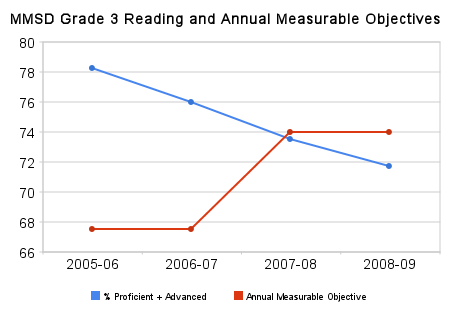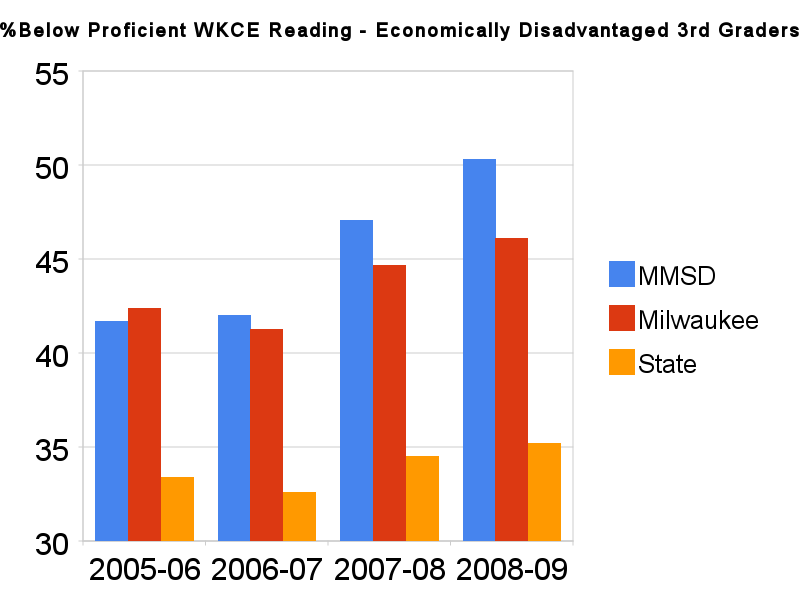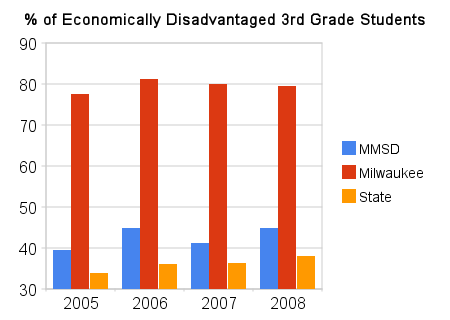“The research around early reading intervention illuminates the complex decision making required to meet individual student literacy needs. There seems to be no one right answer, no quick fix for success. While recent research brings up questions as to the cost/benefit of Reading Recovery, what other supports and options are available? One thing is certain, alternative interventions must be in place prior to removing current systems.” Summary, “Reading Recovery: A Synthesis of Research, Data Analysis and Recommendations,” Madison Metropolitan School District Report to the Board of Education, December, 2009.
How well are we teaching our children to read?
The “Annual Measurable Objectives” under No Child Left Behind for Wisconsin call for all students to achieve reading levels of proficient or better under the WKCE by the 2013-14 school year. Benchmarks toward that goal are phased in over time. The current intermediate goal (ending this school year) is 74%. (Put another way, the percentage of students who are below proficient should not exceed 26%.) The goals move up to 80.5% in 2010-11, 87% in 2011-12, and 93.5% in 2012-13.
71.7% of MMSD 3rd graders scored at or above the proficient level on last year’s (November 2008) WKCE reading assessment (this and the rest of the WKCE data cited here are from the DPI web site). This did not quite meet the 74% Annual Measurable Objective. We should be concerned that achievement levels are going down even as achievement targets are going up:

The Annual Measurable Objectives also apply to demographic subgroups, including economically disadvantaged students. Economically disadvantaged students—whose futures are almost wholly dependent on the ability of their schools to teach them to read—and their achievement levels deserve particular attention.
How well are we teaching our children from low-income families to read?

Can we continue to explain/excuse/blame poverty rates for this failure?

What should we do to acknowledge and address this crisis?
Thank you for taking the time to put this important information together and for sharing it!
There is nothing more important for our 24,295 student Madison Public School District ($418,415,780 current budget: $17,222 per student) than effective reading skill development.
http://www.schoolinfosystem.org/archives/2009/10/10262009_462010.php
I remain concerned, as a taxpayer and parent, that the local public schools are adding too many new initiatives (4k, for example) to the organization without addressing the “basics”, as it were. I’m certain some will argue that 4K is essential to addressing the reading problems Chan raised. Will it? Is it effective? Does it matter? How have other Districts’ students benefited from 4K, or have they?
I’d like to hear more about the 4K connection too. Most districts have it–we don’t–could that be part of the problem? Also, I’m sure that more early, comprehensive screening and treatment for learning disabilities would help.
Thank you for doing this work. I’ve watched the reading “discussions” over the past 10 years, so I’m newish to the ongoing dialogue. What I haven’t seen is reading curriculum analysis done by professionals outside the district who are not tied (in one way, directly or indirectly) to what’s in place and upon which staff has considerable ownership. And too many times, I’ve seen professionals with worldwide experience in reading, who have different opinions than the current paradigm, be ignored, or even worse, treated simply horribly by district officials.
I don’t think the 4K discussion should distract from the discussion of why there is not better success for children to be reading at proficient and advanced levels by the end of third grade. I feel the district’s curriculum staff need to be more challenging of their existing curriculum – and I don’t believe there are mechanisms in place to do this, so it’s easier to look elsewhere for a “solution.” I think the sequence of learning for reading and it’s curriculum are inadequate given the results we are seeing; and the district does not appear to be able to do something different about it. Lots of words, paperwork, but no there there.
Out of curiosity, I went to the WINNS site to look at the proportion of (MMSD-FAY) students taking the 3rd grade reading test who were classified as english language learners.
During the period covered by the graph:
The MMSD data shows that Limited English Proficient 3rd graders included in the test data grew from 16.9% of the testing pool in November 2005, to 28.3% of the testing pool in November 2008.
The Milwaukee public school data, by contrast, shows much less growth in the percentage of 3rd grade english language learners (from 14% to 15%) over the same period.
Assuming a significant degree of overlap in the students who show up in the LEP data and the students who show up in the economically disadvantaged data, this makes a comparison of MMSD and Milwaukee trends during that period a bit dubious. I would think that this would especially be problematic at the 3rd grade level where there are many students in bilingual classrooms who are just beginning to read in english.
Thanks, everyone, for your comments.
I’d like to address briefly the suggestion that the decline in proficiency shown above should be attributed to the increasing proportion of English language learners in the MMSD. It’s true that ELL (which I’ll use here interchangeably with “limited English proficiency” [LEP]) percentages have been increasing in Madison. The DPI data for grade 3 shows an ELL % for Madison of 14.44% at Nov. ’05, increasing to 22.07% at Nov. ’08; Milwaukee goes from 12.36% to 13.03%. (The 16.9%-28.3% numbers in the comment above appear to reflect the number of ELL students divided by the number of non-ELL students, rather than the % of ELL among all students.) The disaggregated data for MMSD shows that “below proficiency” levels for ELL students roughly track those for low-income students. (The stats for Milwaukee, on the other hand, show that the achievement levels of their ELL students have been dropping more significantly than those of their low-income students.) So – while I think it can be said that achievement levels are declining and ELL percentages are increasing, I do not think the data supports the conclusion that achievement levels are declining because ELL percentages are increasing.
Just to clarify, I wasn’t asserting that the decline should be attributed to ELL status–my question was really related to influence, not causation. If I am recollecting correctly, MMSD schools that missed AYP missed based on their LEP subgroup scores. That made me wonder whether Milwaukee schools had a similar demographic and if not, to what extent that muddied the comparison. Regardless, it was not my intent to suggest that any one factor could account for the underachievement problems we are seeing in the district, or to suggest that there wasn’t a problem. Mostly I just wondered if these specific populations, over this specific time period, were similar enough to make useful comparisons. There is no question that both districts still have a lot of work to do in this area.
I apologize for the incorrect statistics and appreciate the correction (you’re absolutely right about how I made the error–wiping egg off of my face as I type….).
I feel we have long neglected the influence/direct correlation between parental behavior and student behavior/achievement.We need to direct our educational garus at Columbia University to spotlight this area for government and private grant studies. I feel that parent/s affected by abuse of drugs and other substances are directly causal to much student failure. Our State Superintendents of Schools, Our Governors and Legislature need lead. We could also hope for Teacher Union support.